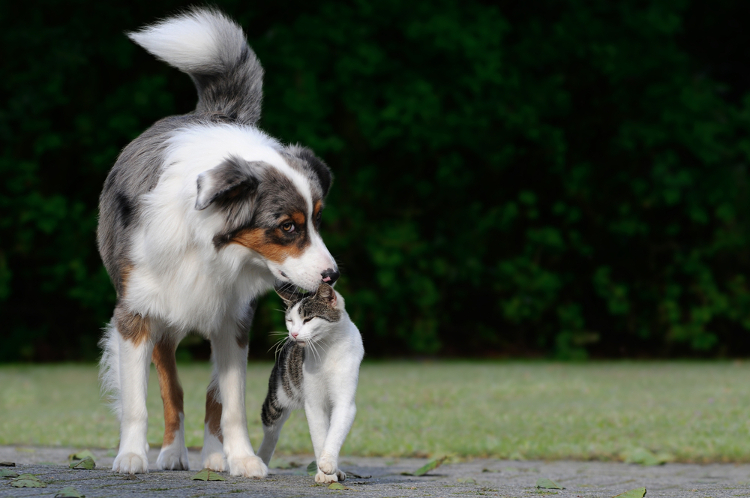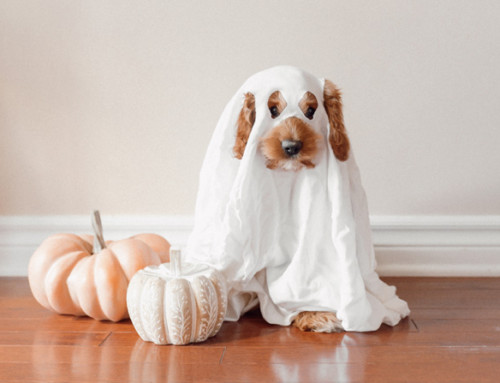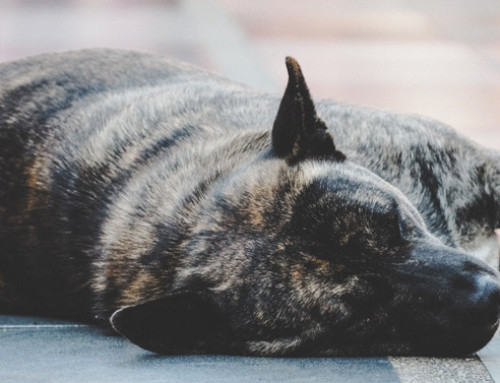Anxiety disorders are the most common mental disorders, affecting one in four Australians at some stage in their life. But do you know that anxiety can also affect your pets?
Anxiety can come in many different forms, however separation anxiety is the most common anxiety type in companion animals, and can cause a decline in thinking, learning and memory. Mild anxiety can cause trembling, withdrawal, hiding, reduced activity, and passive escape behaviours, while more visible behaviours include elimination (urination and/or passage of bowel movements), destruction, and excessive vocalisation (barking or meowing).
Anxiety, whichever form it takes, can be hard to handle, so what do you do if your pet shows signs of anxiety?
Anxiety in dogs
Anxiety in dogs may be more common than you think. You know that ‘naughty’ behaviour your dog has been carrying on with lately? Well in fact dogs dont know how to be “naughty” – it might just be anxious.
When dogs whine or bark excessively, urinate or defecate – all things deemed ‘naughty’ – it’s quite often a sign that they are experiencing some levels of anxiety. Luckily, this is now well understood by most veterinarians, and yours should be able to give you some great tips in how to best manage it, and punishment is most definitely not the way.
Reading symptoms
According to Ashley Atkinson, CPDT-KA and behaviour consultant at Best Friends Animal Sanctuary, “dogs use body language to communicate how they are feeling”. If your dog seems uneasy or fixated on licking, for example, he could be trying to tell you that he’s nervous, stressed or fearful. “It’s important to watch and observe your dog, ” she says, “for his or her own ‘communication style’, and determine what signals he or she uses to indicate anxiety.”
Over time, symptoms may change and you could start noticing pacing, trembling, shaking, hyper-vigilance, lip-licking, frequent yawning or decreased appetite. You could also see increased drooling, dilated pupils, increased heart rate and panting or skin lesions, which highlight over-grooming or self trauma.
What to do
The first step to calming your dog is to understand what it is that’s causing him to feel anxious. As mentioned above, the most common cause of anxiety in companion animals is separation anxiety, but this isn’t always the case.
Getting to the root of the problem is always your best chance at ridding any anxiety your dog may be experiencing.
Separation anxiety
Also known as separation-related distress, separation anxiety relates to problematic behaviours that only occur when a dog is separated from its owner. It could be displayed when an owner goes to work, nips to the shops, or when there’s a physical barrier placed in between the dog and his owner, such as glass or a flyscreen door.
The most common signs of separation anxiety are vocalisation (barking/howling), destructive behaviour, escaping and home soiling (urination/defecation). Having another dog at home isn’t the same as human company, so don’t dismiss separation anxiety on the basis that they’re not ‘alone’. A dog doesn’t have to be ‘alone’ to have separation anxiety – it simply needs to be away from the one it loves most.
The thing with separation anxiety is that it’s always best ‘prevented’ rather than ‘cured’. Start young when your dog is just a puppy by introducing short break periods that gradually get longer. In the time that you’re away, give your dog a longer-lasting or chewy food treat each time you leave, so that they associate your going with a reward. After a while, your puppy will naturally start to look forward to your departure, instead of fearing it.
When dogs are fine but then suddenly start showing signs of separation anxiety, it’s important to look at why this might be. Has there been a change in routine such as an owner returning to work after holidays or extended leave? Perhaps your teen has gone off to university or you’ve recently moved house? Any change in family structure or environment can trigger sudden anxiety.
When this is the case, food is usually your friend. Some people like to start feeding their dog via a food release device to help distract them, while others choose to ‘feed the chooks’ before departure and scatter the lawn with food. Kongs stuffed with treats and Busy Buddies are great, as is a raw meaty bone they can chew on.
Exercise too will be a saving grace – a minimum of 30 minutes twice daily is recommended. One of these walks should be before you depart in the morning and, if possible, should include some off-leash socialisation time.
Additionally, you can invest in some toys and rotate them daily to provide novelty and variety. You should also try (as hard as it may be) to ignore your dog 30 minutes prior to leaving and for the first 30 minutes on your return. Teach your dog to sit and stay, or relax at a distance from you when at home. This may need some encouraging with treats to begin with, but as he gets more comfortable, you can reduce the treats and start increasing the distance.
For dogs with severe separation anxiety, or who don’t respond well to the above tips, there are other treatments available such as pheromone diffusers as well as short- or long-term medication. Talk to your veterinarian about your possible options.
For more information on separation anxiety click here. https://www.petsecure.com.au/pet-training-tips/how-to-deal-with-your-dogs-separation-anxiety/
Weather-related anxiety
Many dogs are fearful of thunder and from the moment there’s a distant grumble will appear on high alert. Dogs also react to lightning, loud noises, ominous darkness and strange air smells, similar in the way that you would. The difference is that you understand what’s happening.
The good thing about thunder-related anxiety is that it’s reasonably predictable. Most of the time your local weather forecast will warn you when a storm is coming, which will allow you to prepare for what’s to come.
There are several steps for keeping your dog safe during storms, including:
- Be at home with your dog: Being alone during a thunderstorm can cause your pooch to feel a great deal of angst, and it’s usually during these times when a dog will escape from your yard or ‘inscape’ into your home and do damage. If you know a storm is coming, try your best to be with your dog, and if possible locate yourselves in the most sound-proof area of your home. If you’re not sure where that might be, look for a room with brick walls rather than timber. If your dog regularly freaks out, you might consider cutting some foam rubber to fit the window cavity of your chosen space.
- Add another noise: Sometimes the best way to drown out big noise is to add more noise. This might sound counter-intuitive, but it’s the same principle that supermarkets use to drown out the noise of shoppers. You can even purchase specialised ‘noises’ music designed exactly for this purpose.
- Pheromones: Dog pheromones can be used to calm noise-fearful dogs but there are different strategies for each. Most work when a diffuser is plugged into a power point, ideally nearby your dog’s bed. The vapour is oil-based and should cover an area of up to 70 square metres for up to four weeks.
- Practice calming strategies: Massage, stroking, brushing hair, whispering, singing softly and talking in a soothing voice is often all it takes to calm a dog suffering from noise-related anxiety. Being calm yourself will help also, as your dog will pick up any anxiety you might be experiencing. If you’re not comfortable in storms and feel on edge, have someone else sit with him when the thunder is at its most intense.
Other dog-related anxiety
If your dog shows signs of anxiety when faced with other dogs, it’s important you address the issue. Use classical conditioning techniques such as pairing another dog meeting with something he loves, such as a treat. Start at a distance your dog is comfortable with, and every time a dog appears, start feeding your dog treats. Keep feeding them rapidly, one after the other and use cheerful chatter to make the experience even more enjoyable. Once the dog is gone, stop the treats and chatter immediately. Repeat the process every time another dog comes by and gradually start getting closer.
Anxiety in cats
Just like dogs, cats get stressed as well. You might not realise this, however, as cats like to hide their anxiety. According to Patricia B. McConnell, Ph.D, many cats suppress their anxieties so much that they expose themselves to a broad range of anxiety-related illnesses.
Just like dogs, cats reveal their anxiety by the way they behave. Signs your cat is experiencing anxiety include:
- Urinating outside the litter box
- Excessive grooming
- Compulsive licking
- Excessive scratching
- Isolation and aloofness
- Excessive vocalisation
- Decreased appetite
- Increased sleeping
- Aggression towards other animals
- Aggression towards people
Again, just like dogs, the management of anxiety has several components – diagnosis (the figuring out of what’s causing the anxiety), assessment of situational factors (a change in environment or family situation), and intervention (the methods used to reduce stress).
Separation anxiety is just as much a problem in cats as it is in dogs, despite them being more ‘independent’. Cats are social creatures and form strong bonds with their owners and other animals, and when separated from these bonds, they can start experiencing anxiety.
The first step is to discuss your situation with your veterinarian and have your cat undergo a physical examination. This will help eliminate any anxiety caused by an underlying health problem – for example, a cat urinating outside the little box could in fact be suffering from a urinary tract infection or a cat grooming excessively could have an undiscovered allergy.
Your vet will also be available to discuss other causes of cat anxiety, such as:
- Overcrowding in multi-cat housing
- Moving house
- New family member (animal or human)
- Parties/visitors
- A new cat next door or in the neighbourhood
- A change in work hours
- Any change at all
The same relaxation principles that apply to dogs can be used to help calm a cat: pheromones, aromatherapy, massage, and classical conditioning. The same ignoring a distraction techniques are recommended too.
Before leaving the house and when returning home, ignore your cat for 30 minutes. Make the home more stimulating too by placing toys around the house or by offering food via a dispenser. A comfortable perch that allows a view from a window serves as a great source of entertainment, especially if there is a bird feeder in sight.
Watching out for pet anxiety
The bottom line is that recognising when your pets are experiencing anxiety is important. By recognising the signs you can take action, and make every day life for your pet that much more enjoyable.







Leave A Comment